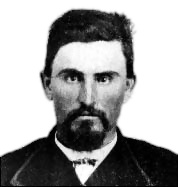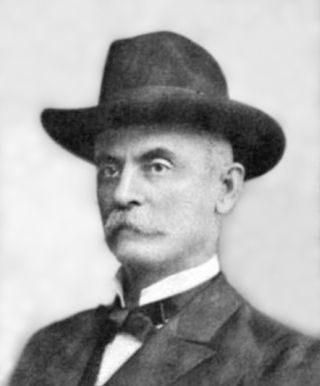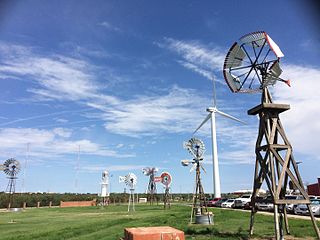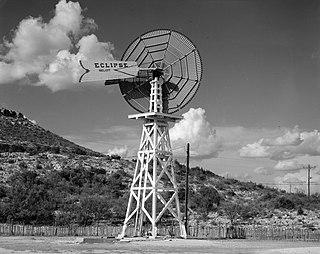
The Texas Longhorn is an American breed of beef cattle, characterized by its long horns, which can span more than 8 ft (2.4 m) from tip to tip. It derives from cattle brought from the Iberian Peninsula to the Americas by Spanish conquistadores from the time of the Second Voyage of Christopher Columbus until about 1512. For hundreds of years the cattle lived a semi-feral existence on the rangelands; they have a higher tolerance of heat and drought than most European breeds. It can be of any color or mix of colors. In some 40% of the cattle it is some shade of red, often a light red; the only shade of red not seen is the deep color typical of the Hereford.

Palo Pinto County is a county located in the U.S. state of Texas. As of the 2020 census, its population was 28,409. The county seat is Palo Pinto. The county was created in 1856 and organized the following year.

Lynn County is a county in the U.S. state of Texas. As of the 2020 census, its population was 5,596. Its county seat is Tahoka. The county was created in 1876 and organized in 1903.

King County is a county located in the U.S. state of Texas. The population was 265 at the 2020 census, making it the second-least populated county in Texas and the third-least populated county in the United States. King County has no incorporated communities. Its county seat is the census-designated place (CDP) of Guthrie. The county was created in 1876 and organized in 1891. It is named for William Philip King, who died at the Battle of the Alamo.

Garza County is a county located in the U.S. state of Texas. As of the 2020 census, its population was 5,816, of which most of the population were residing in its county seat, and only incorporated municipality, Post. The county was created in 1876 and later organized in 1907. Garza is named for a pioneer Bexar County family, as it was once a part of that county.

Hereford is a city in and county seat of Deaf Smith County, Texas, United States. It is 48 miles southwest of Amarillo. Its population was 14,972 at the 2020 census. It is the only incorporated locality named "Hereford" in the country.

Abernathy is a city in Hale and Lubbock counties in the U.S. state of Texas. The population was 2,805 at the 2010 census.

Charles Goodnight, also known as Charlie Goodnight, was a rancher in the American West. In 1955, he was inducted into the Hall of Great Westerners of the National Cowboy & Western Heritage Museum.

Francis Richard Lubbock was a Southern businessman, slaveholder, and politician who played a significant role in Texas history. A South Carolina native, he was a key player in Texas politics, serving as Lieutenant Governor and later the 9th Governor of Texas during the Civil War. As Governor, Lubbock was a fervent supporter of the Confederacy and instrumental in Texas' secession from the Union. After the war, he continued in public service as the Texas State Treasurer. He was the brother of Thomas Saltus Lubbock, for whom both Lubbock County and the city of Lubbock are named.

Oliver Loving was an American rancher and cattle driver. Together with Charles Goodnight, he developed the Goodnight-Loving Trail. He was mortally wounded by Native Americans while on a cattle drive.

John Sparks, nicknamed Honest John, was an American politician who was the 10th Governor of Nevada. Like his predecessor, Reinhold Sadler, Sparks was a cattleman and his rise to political power was evidence of the decline of the mining industry and the rise of the ranching industry in Nevada. He was a member of the Silver – Democratic Party. In 1958, he was inducted into the Hall of Great Westerners of the National Cowboy & Western Heritage Museum.

The American Wind Power Center is a museum of wind power in Lubbock, Texas. Located on 28 acres (110,000 m2) of city park land east of downtown Lubbock, the museum has more than 160 American style windmills on exhibition.

The Canon Ranch Railroad Eclipse Windmill is a historic windpump that was located near Sheffield, Texas.
South Plains Council serves Scouts in the area of Lubbock, Texas.
Christopher Columbus Slaughter (1837–1919) was an American rancher, cattle drover and breeder, banker and philanthropist in the Old West. After serving in the Confederate States Army during the American Civil War of 1861–1865, he came to own 40,000 cattle and over one million acres of ranch land in West Texas. He became the largest taxpayer in Texas, and used his wealth to endow Baptist institutions. He was known as the "Cattle King of Texas."
The Mallet Ranch is a historic ranch in Texas. It was established in Hockley County, Texas in the 1880s. It was used to raise Hereford cattle from the 1900s to the 1930s, with cotton fields added in the mid-1920s. By the late 1930s, oil was discovered. The ranch spanned 45,000 acres in 1990.

George Webb Slaughter (1811–1895) was an American Baptist minister, cattle breeder and drover, and rancher in Texas. Born in Mississippi, he drove cattle to Kansas and Louisiana, from his ranch near Palo Pinto, Texas. According to historian J. Marvin Hunter, "he baptized over 3,000 persons and ordained more preachers and organized more churches than any other person in the state of Texas."

The Four Sixes Ranch, stylized as 6666 Ranch, is a ranch in King County, Texas as well as Carson County and Hutchinson County.
William B. Slaughter (1852–1929) was an American rancher, cattle driver, banker and county judge. Born into a ranching family, he drove cattle and ranched in New Mexico before acquired a ranch in Sherman County, Texas. He founded local banks in Texas and New Mexico, and he was tried but acquitted on suspicion of faulty loans. He retired in San Antonio, Texas.
John Bunyan Slaughter was an American rancher and banker. Born to a ranching family, Slaughter ranched in Texas and New Mexico before acquiring the U Lazy S Ranch in Garza County, Texas, in 1901 and managing it for nearly three decades.








































